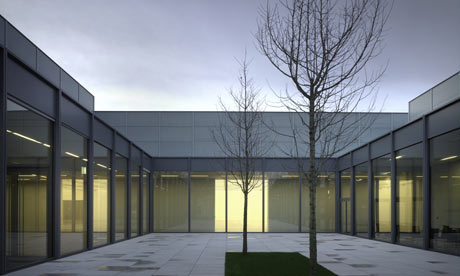David Chipperfield: perfect harmony
Germany woke up to the bold, simple brilliance of David Chipperfield a long time ago. Is Britain finally catching on?

"Art has no greater enemy than the architect," says the newly knighted Chipperfield, eyeing the queue. This, he adds with a smile, is a quote from the late great art critic David Sylvester. "In recent years, art galleries have tended to become freak shows. It's been all about the wackiness of the buildings and not enough about the art." He points to the Folkwang's serene vista of glazed galleries, gleaming amid all the polished concrete and grey steel, and set around a grid of courtyards. "Here, art comes first: you don't have to walk more than a few steps to find it."
What riles Chipperfield is the ruthless commercialism that has taken over the construction process in recent years, leading to so many banal, cheapskate buildings, especially in Britain, where the aim seems to be to deliver as much covered space as possible on the cheap, rounded off with a headline-stealing roof. It's no coincidence that Chipperfield has produced three of his best new buildings in Germany: the Folkwang; the exquisitely proportioned Museum of Modern Literature, perched on a rock plateau in Marbach, in 2006; and the Neues Museum in Berlin, another building shattered during the war and stunningly restored, which opened last year.
A little Margate magic
Indeed, Chipperfield's knighthood is for his services to architecture both in the UK and in Germany, the latter being, by and large, a country still as committed to high-quality architecture as it is to sturdy cars and gleaming trains. The Folkwang, which houses an impressive art collection, is an emphatically modern building. With its single-storey structure, ceiling-to-floor windows, its horizontal lines, free-flowing plan and painstakingly crafted structure, this is Chipperfield's homage to Mies van der Rohe, the great German modernist whose crystal-clear buildings set a standard for a form of architectural purism that has never been surpassed.
"Britain loves a bargain," says Chipperfield, "but you don't get good, lasting architecture on the cheap. If you look at a building by Mies van der Rohe, it might look very simple, but up close, the sheer quality of construction, materials and thought are inspirational."
Chipperfield's unwillingness to compromise has not always made him friends in Britain, where highly crafted modern buildings are the exception. It is something of myth, however, to say he gets no work here. He is currently working on the Hepworth Wakefield sculpture gallery in Yorkshire; the Turner Contemporary, a shiny, angular structure that promises to light up the Margate skyline; and a major refit for the Royal Academy in London. The Turner, in particular, shows how well Chipperfield is able to adapt his rigorous designs to every environment, even something as cherished and unchanging as an English seaside town. Towering over the waves like a modern fort, the gallery will offer ravishing views of the sea that so inspired the painter.
Such projects have taken some while to come through, though. Chipperfield, born in London in 1953 and trained at the Architectural Association, first made his reputation in Japan in the 1980s. What has made him successful, albeit slowly, is his dedication to quality, ideas, and the craft of building: he teaches architecture as well as practising it, and ran an architectural gallery called 9H, named after the hardest kind of pencil. (It was created to bring wider attention to what were then obscure European firms, such as Herzog and de Meuron.)
To read the full article http://www.guardian.co.uk/artanddesign/2010/feb/03/david-chipperfield

No comments:
Post a Comment